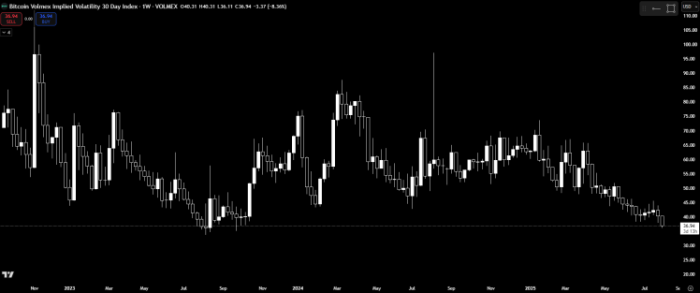Bitcoin’s volatility just hit its lowest point since September 2023. This event could be a signal that a major shift in Bitcoin and crypto market conditions is unfolding.
According to the , Bitcoin’s 30-day implied volatility fell to a low of 36.11%. These levels haven’t been seen since September 30, 2023, back when BTC was trading below $30,000.
And then, it was just days away from aggressively breaking out to the upside.
Fast forward to today: Bitcoin is holding strong well above $114K, and yet, volatility has all but collapsed. This divergence is a big deal: it suggests that $BTC is starting to behave more like a TradFi asset, where bull runs are often accompanied by periods of low-volatility lulls.For savvy investors, this creates a rare window of opportunity. When the market is calm and slowly grinding up, it often sets the stage for huge upside. This is especially true for altcoins like , which are built to ride Bitcoin’s momentum with extra utility and speed.

Bitcoin is currently consolidating between $110,000 and $120,000; but the real story is under the hood. The 30-day implied volatility (IV), tracked by the BVIV index, dropped to 36.11% today – a level unseen since 2023.
Historically, Bitcoin’s volatility would rise during price surges, reflecting high levels of fear, excitement, and speculation.
However, this cycle appears to be different. Despite $BTC gaining over 50% since its lows in April, volatility has been steadily trending down. In fact, , Bitcoin’s volatility is at a historical low, currently less than twice that of Gold’s.

So what’s changed?
Analysts point to the growing use of institutional-style structured products, such as options and ETFs, that suppress BTC’s volatility.
As more institutions and other large players enter the space, Bitcoin is increasingly mirroring TradFi markets like the S&P 500 or Gold, where slow, upward trends tend to dampen volatility rather than ignite it.
In traditional finance, falling volatility during bullish periods in the market is a sign of growing confidence, not weakness. It suggests that investors truly believe in the trend, and aren’t aggressively taking profits or scrambling for hedges.
Bitcoin’s current implied volatility downtrend reflects that exact dynamic. As fear subsides, institutions are more likely to step in, looking for steady, scalable exposure. That’s already playing out through rising ETF inflows and increased interest in tokenized real-world assets (RWAs).More importantly, this creates the ideal environment for infrastructure-focused plays – especially those that scale Bitcoin.
That’s where comes in: a lightning-fast Bitcoin Layer 2 designed to handle the next big wave of on-chain activity. As capital rotates into $BTC and its adjacent ecosystems, low volatility sets the stage for long-term narratives, not just short-term pumps.
The calmer the market appears on the face of it, the more serious money gets involved. And scalable, utility-driven projects like Bitcoin Hyper are perfectly placed to benefit.
With Bitcoin finding its footing around $115K and volatility at 2-year lows, the stage is set for a new wave of infrastructure-focused projects, and those that solve Bitcoin’s biggest flaw – its scalability – are likely to thrive the most.
is a Layer 2 rollup built on the Solana Virtual Machine (SVM), anchored directly to Bitcoin. This design gives it the speed, programmability, and flexibility of Solana, while still relying on Bitcoin’s battle-tested security.
In short, it makes Bitcoin scalable, programmable, and DeFi-ready.
With all the institutional capital flowing into $BTC via ETPs and RWA protocols, projects like Bitcoin Hyper are the obvious next step for Bitcoin: a fast, low-cost environment for dApps, staking, and yield generation built around BTC.
The project has already raised over $7.4M in its presale, and is still available in one of its final early-stage price tiers, at $0.01255 per token. This makes it a rare entry point for investors eyeing the next breakout Bitcoin infrastructure narrative.

If $BTC is the base layer for institutional crypto, Hyper is shaping up to be the engine for its next wave of innovation.
Check out the today!
Bitcoin’s low volatility might look like a lull, but it’s often the calm before the storm.
As the market matures and BTC starts behaving more like TradFi assets, the smart money is already rotating into infrastructure projects that support long-term scalability.
Bitcoin Hyper is one of the most compelling plays of this kind. It combines the security of Bitcoin with the speed and flexibility of the Solana VM.
If you’re waiting for a signal to act, it’s already here; don’t wait for volatility to spike. The could be your early entry into the next big wave.
Disclaimer: This article is for informational purposes only and does not constitute investment advice. Cryptocurrency investments are highly volatile and carry significant risk. Always do your own research and consult a licensed financial advisor before making any financial decisions.